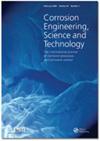Effects of solid deposits on the corrosion behaviour of titanium in high acidity and highly oxidising leaching solutions
IF 1.5
4区 材料科学
Q4 MATERIALS SCIENCE, MULTIDISCIPLINARY
Corrosion Engineering, Science and Technology
Pub Date : 2022-11-24
DOI:10.1080/1478422X.2022.2149048
引用次数: 0
Abstract
ABSTRACT Solid minerals are ubiquitous and common deposits on Ti-lined process vessels in the hydrometallurgical industry. This work revealed the effects of inert solid deposits on the corrosion behaviour of Ti-2 in high acidity and highly oxidising leaching solutions. It was found that the deposit-covered Ti-2 had a higher corrosion rate (CR) than bare Ti-2. CR increased with increasing deposit thickness (up to 6 cm) and temperature. Solid deposits mainly affected the corrosion process of Ti by limiting the mass transfer of the oxidising Fe(III) from the bulk solution to the underlying Ti, thus affecting the stability of the protective passive film, and resulting in an accelerated passive CR. High temperatures and solid deposition are both commonly encountered in the hydrometallurgical industry, and their combination may significantly limit the maximum service temperature of Ti-equipment, implying that there is a risk in using Ti-components under such conditions.固体沉积物对钛在高酸性和高氧化性浸出溶液中腐蚀行为的影响
摘要在湿法冶金工业中,固体矿物是衬钛工艺容器上普遍存在的常见沉积物。这项工作揭示了惰性固体沉积物对Ti-2在高酸度和高氧化浸出溶液中腐蚀行为的影响。研究发现,镀层覆盖的Ti-2比裸露的Ti-2具有更高的腐蚀速率(CR)。CR随着沉积物厚度的增加而增加(高达6 cm)和温度。固体沉积物主要通过限制氧化性Fe(III)从本体溶液到下层Ti的传质来影响Ti的腐蚀过程,从而影响保护性钝化膜的稳定性,并导致钝化CR加速。高温和固体沉积在湿法冶金工业中都很常见,并且它们的组合可能显著限制Ti设备的最高使用温度,这意味着在这种条件下使用Ti部件存在风险。
本文章由计算机程序翻译,如有差异,请以英文原文为准。
求助全文
约1分钟内获得全文
求助全文
来源期刊

Corrosion Engineering, Science and Technology
工程技术-材料科学:综合
CiteScore
3.20
自引率
5.60%
发文量
58
审稿时长
3.4 months
期刊介绍:
Corrosion Engineering, Science and Technology provides broad international coverage of research and practice in corrosion processes and corrosion control. Peer-reviewed contributions address all aspects of corrosion engineering and corrosion science; there is strong emphasis on effective design and materials selection to combat corrosion and the journal carries failure case studies to further knowledge in these areas.
 求助内容:
求助内容: 应助结果提醒方式:
应助结果提醒方式:


